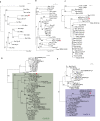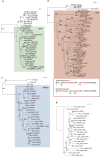The ancestral gene repertoire of animal stem cells
- PMID: 26644562
- PMCID: PMC4697369
- DOI: 10.1073/pnas.1514789112
The ancestral gene repertoire of animal stem cells
Abstract
Stem cells are pivotal for development and tissue homeostasis of multicellular animals, and the quest for a gene toolkit associated with the emergence of stem cells in a common ancestor of all metazoans remains a major challenge for evolutionary biology. We reconstructed the conserved gene repertoire of animal stem cells by transcriptomic profiling of totipotent archeocytes in the demosponge Ephydatia fluviatilis and by tracing shared molecular signatures with flatworm and Hydra stem cells. Phylostratigraphy analyses indicated that most of these stem-cell genes predate animal origin, with only few metazoan innovations, notably including several partners of the Piwi machinery known to promote genome stability. The ancestral stem-cell transcriptome is strikingly poor in transcription factors. Instead, it is rich in RNA regulatory actors, including components of the "germ-line multipotency program" and many RNA-binding proteins known as critical regulators of mammalian embryonic stem cells.
Keywords: Porifera; RNA binding; evolution; stem cells; uPriSCs.
Conflict of interest statement
The authors declare no conflict of interest.
Figures








References
-
- Tiozzo S, Brown FD, De Tomaso AW. Regeneration and stem cells in ascidians. In: Bosch TCG, editor. Stem Cells from Hydra to Man. Springer; Berlin: 2008. pp. 95–112.
-
- Shibata N, et al. Comprehensive gene expression analyses in pluripotent stem cells of a planarian, Dugesia japonica. Int J Dev Biol. 2012;56(1-3):93–102. - PubMed
-
- Agata K, et al. Two different evolutionary origins of stem cell systems and their molecular basis. Semin Cell Dev Biol. 2006;17(4):503–509. - PubMed
Publication types
MeSH terms
Substances
Associated data
LinkOut - more resources
Full Text Sources
Other Literature Sources
Medical
Molecular Biology Databases

